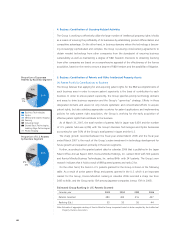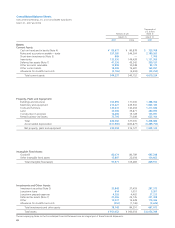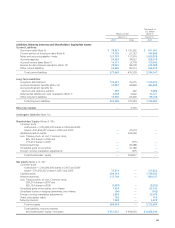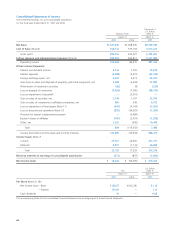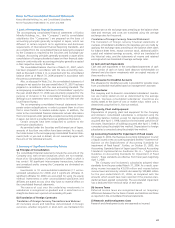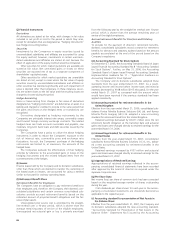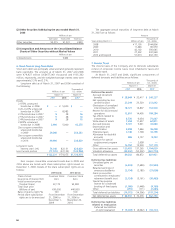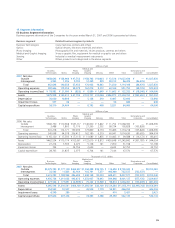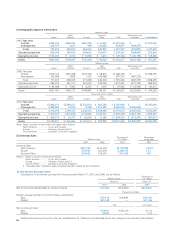Konica Minolta 2007 Annual Report Download - page 50
Download and view the complete annual report
Please find page 50 of the 2007 Konica Minolta annual report below. You can navigate through the pages in the report by either clicking on the pages listed below, or by using the keyword search tool below to find specific information within the annual report.48
(j) Financial Instruments
Derivatives
All derivatives are stated at fair value, with changes in fair value
included in net profit or loss for the period in which they arise,
except for derivatives that are designated as “hedging instruments”
(see Hedge Accounting below).
Securities
Investments by the Companies in equity securities issued by
unconsolidated subsidiaries and affiliates are accounted for using
the equity method; however, investments in certain unconsoli-
dated subsidiaries and affiliates are stated at cost because the
effect of application of the equity method would be immaterial.
Other securities for which market quotations are available are
stated at fair value. Net unrealized gains or losses on these
securities are reported net of tax as a separate component of
shareholders’ equity/net assets.
Other securities for which market quotations are unavailable
are stated at cost, except in cases where the fair value of equity
securities issued by unconsolidated subsidiaries and affiliates or
other securities has declined significantly and such impairment of
value is deemed other than temporary. In these instances, securi-
ties are written down to the fair value and the resulting losses are
charged to income during the period.
Hedge Accounting
Gains or losses arising from changes in fair value of derivatives
designated as “hedging instruments” are deferred as an asset or a
liability and charged or credited to income in the same period that
the gains and losses on the hedged items or transactions are
recognized.
Derivatives designated as hedging instruments by the
Companies are principally interest rate swaps, commodity swaps
and forward foreign currency exchange contracts. The related
hedged items are trade accounts receivable and payable, raw
materials, long-term bank loans and debt securities issued by the
Companies.
The Companies have a policy to utilize the above hedging
instruments in order to reduce the Companies’ exposure to the
risk of interest rate, commodity price and exchange rate
fluctuations. As such, the Companies’ purchases of the hedging
instruments are limited to, at maximum, the amounts of the
hedged items.
The Companies evaluate the effectiveness of their hedging
activities by reference to the accumulated gains or losses on the
hedging instruments and the related hedged items from the
commencement of the hedges.
(k) Leases
Finance leases held by the Company and its domestic subsidiaries,
other than those which are deemed to transfer the ownership of
the leased assets to lessees, are accounted for using a method
similar to that used for ordinary operating leases.
(l) Retirement Benefit Plans
Retirement Benefits for Employees
The Companies have an obligation to pay retirement benefits to
their employees and, therefore, the Company, their domestic con-
solidated subsidiaries and certain overseas consolidated sub-
sidiaries provide accrued retirement benefits based on the
estimated amount of projected benefit obligations and the fair
value of plan assets.
Unrecognized prior service cost is amortized by the straight-
line method over a 10-year period, which is shorter than the
average remaining years of service of the eligible employees.
Unrecognized net actuarial gain or loss is primarily amortized
from the following year by the straight-line method over 10-year
period, which is shorter than the average remaining years of
service of the eligible employees.
Accrued retirement Benefits for Directors and Statutory
Auditors
To provide for the payment of directors' retirement benefits,
domestic consolidated subsidiaries record a reserve for retirement
benefits for directors and statutory auditors based on the amount
payable accumulated at the end of the period based on the
Company's regulations.
(m) Accounting Standard for Stock Options
On December 27, 2005, the Accounting Standards Board of Japan
issued Financial Accounting Standard No.8 “Accounting Standard
for Stock Options”. Further, on May 31, 2006, the Accounting
Standards Board of Japan issued Financial Accounting Standards
Implementation Guidance No. 11 – “Application Guidance on
Accounting Standard for Stock Options”.
The Company and its domestic subsidiaries adopted these
standards from the year ended March 31, 2007. As a result,
operating income and income before income taxes and minority
interests decreased by ¥108 million ($915 thousand), for the year
ended March 31, 2007 as compared with the amount which
would have been reported if the previous standards had been
applied consistently.
(n) Accounting standard for retirement benefits in the
United Kingdom
Effective from the year ended March 31, 2006, consolidated sub-
sidiaries Konica Minolta Business Solutions (UK) Ltd. and Konica
Minolta Photo Imaging (UK) Ltd. adopted a new accounting
standard for retirement benefits in the United Kingdom.
Retained earnings decreased by ¥2,611 million since the net
retirement benefit obligation at the transition date and actuarial
gains and losses were charged directly to retained earnings for the
year ended March 31, 2006.
(o) Accounting standard for retirement benefits in the
United States
Effective from the year ended March 31, 2007, consolidated
subsidiaries Konica Minolta Business Solutions U.S.A., Inc., adopt-
ed a new accounting standard for retirement benefits in the
United States.
Retained earnings increased by ¥137 million and actuarial
gains and losses were charged directly to retained earnings for the
year ended March 31, 2007.
(p) Appropriations of Retained Earnings
Appropriations of retained earnings reflected in the accom-
panying consolidated financial statements have been recorded
after approval by the board of directors as required under the
Japanese Corporate Law.
(q) Per Share Data
Net income (loss) per share of common stock has been computed
based on the weighted-average number of shares outstanding
during the year.
Cash dividends per share shown for each year in the accom-
panying consolidated statements are dividends declared as
applicable to the respective year.
(r) Accounting standard for presentation of Net Assets in
the Balance Sheet
Effective from the year ended March 31, 2007, the Company and
its domestic subsidiaries adopted the new accounting standard,
“Accounting Standard for Presentation of Net Assets in the
Balance Sheet” (Statement No.5 issued by the Accounting




